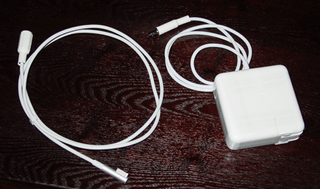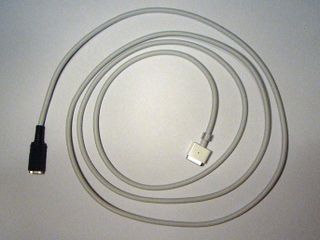External Battery Roundup: Stay Away From The Wall Socket
MikeGyver: The Mac Solution
You use a Mac, then you know that everything got a little more complicated with the MagSafe connector. There are very few ways to get an external battery to work with your MacBook. One roundabout way is to output 12 V to a cigarette adapter and use Apple’s Airline MagSafe adapter. Only the PowerGorilla and XP18000 support that option, but the cigarette adapter is separate purchase in the case of the XP18000.
There is a big problem with this suggestion, though. The current Airline MagSafe connector doesn’t actually step up the voltage. It just delivers 12 V to the computer, which is enough to keep the notebook alive. Unfortunately, it isn't enough to charge the battery. In fact, it doesn’t even really fully power the larger 15.6" and 17.3" MacBook Pros. The larger systems switch from 16 V to 19 V during heavier workloads, so you'd only really slow down the rate of discharge.
Apple is the only major notebook vendor that supplies a branded non-charging auto option, which makes this somewhat of an anomaly. Some people have resorted to modifying the Airline MagSafe adapter, but it doesn't come with a charging circuit. No amount of modification is going to solve your charging problem.

There are options coming from HyperMac (HyperJuice looks interesting) and QuickerTek. Trouble started a few months back when Apple claimed that HyperMac was manufacturing cables with MagSafe connectors, violating the Cupertino-based company's patent.
Meanwhile, there was Mike Lee of MikeGyver, plugging along. Before MagSafe was even a blip on the radar, Mike made mods for PowerBooks. Apples employees even use his kits because he warranties his work. Mike actually cuts a MagSafe cable off of a retail Apple power adapter and modifies the input end to accept the 16 V plug used by the last generation of IBM ThinkPads. This simple adjustment allows you to charge your MBP, provided you have his modified cable and an adapter that can output to the old 16 V ThinkPad tip. This is completely legal because it's not a counterfeit Apple product. It is simply a mod, and selling a mod is legal under the principle of first use.
There is a downside to this, though. You must use either use a modified Apple power adapter from MikeGyver or switch over to a third-party power adapter.
You can attempt to do this yourself, as others have, but it's an involved process. The elastic sheath on the cable makes it hard to modify, since you need to always keep it taut and straightened out. If you are willing to supply your own adapter, or if you have a custom setup requirement, Mike usually just charges the labor fee for modifying the plug.
Stay on the Cutting Edge
Join the experts who read Tom's Hardware for the inside track on enthusiast PC tech news — and have for over 25 years. We'll send breaking news and in-depth reviews of CPUs, GPUs, AI, maker hardware and more straight to your inbox.

There are a number of quirks associated with this approach, but the point is that it works. In fact, we have tried it on new 13.3" MacBook Pro using all of the batteries in our roundup. It works without flaw.
If you are going to attempt to do this yourself, you need to be careful. One of the criticisms of the MagSafe design is that the contacts are too small for the the charging current. Furthermore, the magnet used in the connector attracts iron filings and other ferromagnetic materials. Just Google "MagSafe fire." After creating your own cable, your MagSafe plug may be dirty from its time in the lab. Play it safe and clean up the plug. You can do this with candle wax.
- Drip candle wax onto a surface.
- Knead it until it is just slightly warm and malleable.
- Press it against the MagSafe connector. The wax will pick up any filings or ferromagnetic dust.
- Wipe down the MagSafe connector with a soft cloth to get rid of the wax.
Do not put the MagSafe connector in contact with hot wax. Only do this after it has cooled. A magnet will lose part of its magnetic force when it comes into contact with heat (100 °C). You can also use masking tape, but warm wax is the surest way to get rid of even the smallest filings.
Current page: MikeGyver: The Mac Solution
Prev Page Tekkeon myPower ALL Plus MP3750, MP3450, MP3450i Next Page Test Setup-
lashabane Excellent article. I had an idea that this stuff was out there but never really bothered to look. If the 4-5 hours I get from my Asus 1215t begins to not cut it, I now know where to look. Thanks!Reply -
zodiacfml I did not understood any of the technical reading especially the part about the desktop PSU.Reply
At one point, it is stated that AC adapters have higher voltage than the battery on a notebook so that it can be charged. Then, how can a external battery damage a notebook's electronics with a higher voltage (only if it's too high)?
It is not stated how to set the external battery voltage correctly. What then is the correct voltage? Correct me but I believe the voltage has to be equal that of notebook battery.
-
burnley14 It's pretty remarkable that after page 2 I could guess who the author of this article was (without looking of course) due to the thoroughness and good grammar/lack of typos. Hats off to you yet again, Mr. Ku. Job well done as always.Reply -
nukemaster zodiacfmlI did not understood any of the technical reading especially the part about the desktop PSU.At one point, it is stated that AC adapters have higher voltage than the battery on a notebook so that it can be charged. Then, how can a external battery damage a notebook's electronics with a higher voltage (only if it's too high)? It is not stated how to set the external battery voltage correctly. What then is the correct voltage? Correct me but I believe the voltage has to be equal that of notebook battery.Your guess is actually right. The battery with its voltage set too high can damage the notebook.Reply
If you need to know the voltage required, you just check on your laptop AC adapter or power brick. It is not always the same as the battery.
For instance, a Compaq R3000 has an 18.5 volt AC->DC(120w) power supply and its battery is only 14.5 volts. The voltage regulators in the laptop(in the charging system) it self cut it down to the needed 14.5-15volts to charge the battery.
Also note that the AC adapter does NOT spit out AC it in fact spits out DC(it has a rectifier to convert AC to DC).
As you can see by this picture(you have to click the link), The adapter takes in AC 120V and spits out DC 18.5V. AC is shown with a ~ and DC with a --_---_-- cant make it on here, but you get the point.
http://img269.imageshack.us/img269/1950/powerw.jpg -
Luscious Quite a different experience on my end testing the Energizer XP8000 and XP18000.Reply
For my smartphone and MiFi, the XP8000 just can't be beat. 5x runtime guarantees me 20+ hours of 3G broadband and week-long phone use. Being barely bigger than a Blackberry, I can effortlessly stash the XP8000 on my belt, and charge my smartphone while I walk.
The XP18000, on the other hand, was a huge disappointment. Using a Toshiba NB305 netbook, it was incapable of recharging the factory 6-cell battery while powered on, and could not provide 2 full charges while powered off. For my usage scenario, that's a failure, as I plug in the external battery when my netbook hits 3% critical, right before Windows does a force shutdown, allowing me to continue working.
Using this deplete-charge-deplete approach SHOULD allow me 14+ hours of continuous power-on time, except that even the beefy XP18000 couldn't get through 1 netbook charge. Had it been capable of providing one full charge powered on, or two full charges powered off, I would have recommended the XP18000 as well.
http://lgponthemove.blogspot.com/2010/07/accessory-corner-3-energizer-xp18000.html -
a_fortiori Nice article. I wonder if these units can be used as a mini-ups for equipment like a NAS, routers and modems. It would be great if you could wire these with the NAS, and be sure that a power outage wouldn't damage the NAS. Considering that the NAS units typically consume much less power than a notebook, these should be able to cover 4-5 hrs of power outage (?) Any thoughts?Reply -
junixophobia shineon2010Very good info , alot of products that im having second thoughts about.Reply
Just buy an automatic inverter that works for hours with a car battery
Most Popular

